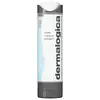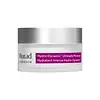What's inside
What's inside
 Key Ingredients
Key Ingredients

 Benefits
Benefits

 Concerns
Concerns

 Ingredients Side-by-side
Ingredients Side-by-side

Water
Skin ConditioningGlycerin
HumectantBehenyl Alcohol
EmollientSorbitol
HumectantCaprylic/Capric Triglyceride
MaskingHydroxyethyl Urea
HumectantPropanediol
SolventCetyl Ethylhexanoate
EmollientCetyl Alcohol
EmollientGlyceryl Stearate
EmollientCarthamus Tinctorius Oleosomes
EmollientHydrolyzed Jojoba Esters
Skin ConditioningBetaine
HumectantBambusa Arundinacea Stem Extract
Skin ConditioningMelia Azadirachta Leaf Extract
Skin ConditioningMelia Azadirachta Flower Extract
Skin ConditioningCorallina Officinalis Extract
Skin ConditioningCucumis Sativus Fruit Extract
EmollientCoccinia Indica Fruit Extract
Skin ConditioningAcacia Decurrens Extract
AstringentRicinus Communis Seed Oil
MaskingAloe Barbadensis Flower Extract
EmollientSolanum Melongena Fruit Extract
Skin ConditioningAverrhoa Carambola Fruit Extract
Skin ConditioningNephelium Lappaceum Branch/Fruit/Leaf Extract
Skin ConditioningSaccharomyces/Xylinum/Black Tea Ferment
Skin ConditioningSpirulina Maxima Extract
SmoothingTremella Fuciformis Extract
HumectantViola Odorata Leaf Extract
MaskingCurcuma Longa Root Extract
MaskingOcimum Basilicum Flower/Leaf Extract
TonicOcimum Sanctum Leaf Extract
Skin ConditioningBacillus Ferment
Skin ConditioningSodium Hyaluronate
HumectantTriethyl Citrate
MaskingPEG-75 Stearate
Pentylene Glycol
Skin ConditioningXanthan Gum
EmulsifyingPhytosteryl Oleate
Skin Conditioning1,2-Hexanediol
Skin ConditioningCeteth-20
CleansingSteareth-20
CleansingC12-13 Pareth-3
EmulsifyingCaprylyl Glycol
EmollientTitanium Dioxide
Cosmetic ColorantLactic Acid
BufferingButylene Glycol
HumectantPhenylpropanol
MaskingEthylhexylglycerin
Skin ConditioningCalcium Alginate
MaskingJojoba Esters
EmollientAminomethyl Propanol
BufferingPolyquaternium-10
Citric Acid
BufferingDipotassium Glycyrrhizate
HumectantGluconic Acid
Biosaccharide Gum-4
Skin ConditioningPhytosterols
Skin ConditioningSodium Benzoate
MaskingXylitol
Humectant3-Hexenol
MaskingSodium Acetate
BufferingSodium Chloride
MaskingIsopropyl Alcohol
SolventCaprylhydroxamic Acid
Water, Glycerin, Behenyl Alcohol, Sorbitol, Caprylic/Capric Triglyceride, Hydroxyethyl Urea, Propanediol, Cetyl Ethylhexanoate, Cetyl Alcohol, Glyceryl Stearate, Carthamus Tinctorius Oleosomes, Hydrolyzed Jojoba Esters, Betaine, Bambusa Arundinacea Stem Extract, Melia Azadirachta Leaf Extract, Melia Azadirachta Flower Extract, Corallina Officinalis Extract, Cucumis Sativus Fruit Extract, Coccinia Indica Fruit Extract, Acacia Decurrens Extract, Ricinus Communis Seed Oil, Aloe Barbadensis Flower Extract, Solanum Melongena Fruit Extract, Averrhoa Carambola Fruit Extract, Nephelium Lappaceum Branch/Fruit/Leaf Extract, Saccharomyces/Xylinum/Black Tea Ferment, Spirulina Maxima Extract, Tremella Fuciformis Extract, Viola Odorata Leaf Extract, Curcuma Longa Root Extract, Ocimum Basilicum Flower/Leaf Extract, Ocimum Sanctum Leaf Extract, Bacillus Ferment, Sodium Hyaluronate, Triethyl Citrate, PEG-75 Stearate, Pentylene Glycol, Xanthan Gum, Phytosteryl Oleate, 1,2-Hexanediol, Ceteth-20, Steareth-20, C12-13 Pareth-3, Caprylyl Glycol, Titanium Dioxide, Lactic Acid, Butylene Glycol, Phenylpropanol, Ethylhexylglycerin, Calcium Alginate, Jojoba Esters, Aminomethyl Propanol, Polyquaternium-10, Citric Acid, Dipotassium Glycyrrhizate, Gluconic Acid, Biosaccharide Gum-4, Phytosterols, Sodium Benzoate, Xylitol, 3-Hexenol, Sodium Acetate, Sodium Chloride, Isopropyl Alcohol, Caprylhydroxamic Acid
Water
Skin ConditioningEthylhexyl Palmitate
EmollientBetaine
HumectantCetearyl Methicone
Skin ConditioningCetearyl Alcohol
EmollientCetyl Myristate
EmollientStearyl Dimethicone
EmollientMacadamia Ternifolia Seed Oil
EmollientPyrus Malus Fruit Extract
Skin ConditioningGlycerin
HumectantButylene Glycol
HumectantButyrospermum Parkii Butter
Skin ConditioningPolyglyceryl-3 Polydimethylsiloxyethyl Dimethicone
Skin ConditioningPolysorbate 60
EmulsifyingDimethicone
EmollientBehenyl Alcohol
EmollientGlycol Distearate
EmollientMentha Viridis Leaf Oil
AstringentPogostemon Cablin Leaf Oil
MaskingCitrus Medica Peel Oil
Lavandula Hybrida Oil
EmollientMentha Arvensis Leaf Oil
MaskingCedrus Atlantica Bark Oil
MaskingChlorella Emersonii Extract
Skin ConditioningMirabilis Jalapa Extract
Skin ConditioningTocopherol
AntioxidantHelianthus Annuus Seed Extract
Skin ConditioningCoccinia Indica Fruit Extract
Skin ConditioningSolanum Melongena Fruit Extract
Skin ConditioningOcimum Sanctum Leaf Extract
Skin ConditioningCurcuma Longa Root Extract
MaskingCorallina Officinalis Extract
Skin ConditioningOcimum Basilicum Flower/Leaf Extract
TonicSimmondsia Chinensis Seed Oil
EmollientAloe Barbadensis Flower Extract
EmollientMelia Azadirachta Leaf Extract
Skin ConditioningMelia Azadirachta Flower Extract
Skin ConditioningUrea
BufferingYeast Amino Acids
HumectantTrehalose
HumectantInositol
HumectantTaurine
BufferingXanthan Gum
EmulsifyingPropanediol
SolventOctadecene
SolventPolysorbate 20
EmulsifyingSodium Hydroxide
BufferingDisodium EDTA
Hexylene Glycol
EmulsifyingEthylhexylglycerin
Skin ConditioningCaprylyl Glycol
EmollientPhenoxyethanol
PreservativeLimonene
PerfumingLinalool
PerfumingWater, Ethylhexyl Palmitate, Betaine, Cetearyl Methicone, Cetearyl Alcohol, Cetyl Myristate, Stearyl Dimethicone, Macadamia Ternifolia Seed Oil, Pyrus Malus Fruit Extract, Glycerin, Butylene Glycol, Butyrospermum Parkii Butter, Polyglyceryl-3 Polydimethylsiloxyethyl Dimethicone, Polysorbate 60, Dimethicone, Behenyl Alcohol, Glycol Distearate, Mentha Viridis Leaf Oil, Pogostemon Cablin Leaf Oil, Citrus Medica Peel Oil, Lavandula Hybrida Oil, Mentha Arvensis Leaf Oil, Cedrus Atlantica Bark Oil, Chlorella Emersonii Extract, Mirabilis Jalapa Extract, Tocopherol, Helianthus Annuus Seed Extract, Coccinia Indica Fruit Extract, Solanum Melongena Fruit Extract, Ocimum Sanctum Leaf Extract, Curcuma Longa Root Extract, Corallina Officinalis Extract, Ocimum Basilicum Flower/Leaf Extract, Simmondsia Chinensis Seed Oil, Aloe Barbadensis Flower Extract, Melia Azadirachta Leaf Extract, Melia Azadirachta Flower Extract, Urea, Yeast Amino Acids, Trehalose, Inositol, Taurine, Xanthan Gum, Propanediol, Octadecene, Polysorbate 20, Sodium Hydroxide, Disodium EDTA, Hexylene Glycol, Ethylhexylglycerin, Caprylyl Glycol, Phenoxyethanol, Limonene, Linalool
 Reviews
Reviews

Ingredients Explained
These ingredients are found in both products.
Ingredients higher up in an ingredient list are typically present in a larger amount.
Aloe Barbadensis Flower Extract is an extract of the flowers of the aloe, Aloe barbadensis, Liliaceae
Aloe contains the antioxidants Vitamins A, C, and E.
It also contains sugars in the form of monosaccharides and polysaccharides, folic acid, choline, many common minerals such as calcium, 12 anthraquinones, fatty acids, amino acids, and Vitamin B12.
Aloe is known to be anti-inflammatory, moisturizing, antiseptic, healing, and protect against UV rays.
Learn more about Aloe Barbadensis Flower ExtractBehenyl Alcohol is a type of fatty alcohol (these are different from the drying, solvent alcohols).
Fatty Alcohols have hydrating properties and are most often used as an emollient or to thicken a product. They are usually derived from natural fats and oils; behenyl alcohol is derived from the fats of vegetable oils.
Emollients help keep your skin soft and hydrated by creating a film that traps moisture in.
In 2000, Behenyl Alcohol was approved by the US as medicine to reduce the duration of cold sores.
Learn more about Behenyl AlcoholBetaine is a common humectant (a substance that promotes retention of moisture). It's known to be gentle on the skin and can help balance hydration.
This ingredient is best for improving hydration and soothing irritated skin. Studies also show it helps even out skin tone.
Fun fact: Betaine is naturally created in the skin and body. The kind found within cosmetic products can be either plant-derived or synthetic.
Another name for betaine is trimethylglycine.
Learn more about BetaineButylene Glycol (or BG) is used within cosmetic products for a few different reasons:
Overall, Butylene Glycol is a safe and well-rounded ingredient that works well with other ingredients.
Though this ingredient works well with most skin types, some people with sensitive skin may experience a reaction such as allergic rashes, closed comedones, or itchiness.
Learn more about Butylene GlycolCaprylyl Glycol is a humectant and emollient, meaning it attracts and preserves moisture.
It is a common ingredient in many products, especially those designed to hydrate skin. The primary benefits are retaining moisture, skin softening, and promoting a healthy skin barrier.
Though Caprylyl Glycol is an alcohol derived from fatty acids, it is not the kind that can dry out skin.
This ingredient is also used as a preservative to extend the life of products. It has slight antimicrobial properties.
Learn more about Caprylyl GlycolCoccinia Indica Fruit Extract is also known as Ivy Gourd Fruit Extract. It has skin conditioning properties.
Corallina Officinalis Extract is from the red seaweed, Corallina Officinalis. This seaweed is found all over the world but is most common in the rocky shores of Great Britain and Ireland.
Corallina Officinalis Extract contains antioxidant and emollient properties.
Extracted polysaccharides, galactose and xylose, in red algae showed antioxidant activity. Antioxidants help with anti-aging by neutralizing free-radical molecules. Free-radical molecules may damage your skin cells and DNA. Galactose is also a PHA.
Corallina Officinalis is structurally similar to coral due to its high calcium content.
Learn more about Corallina Officinalis ExtractCurcuma Longa Root Extract is from the spice, turmeric. Besides being a healthy and delicious spice, turmeric also has plenty of skincare benefits. It has anti-inflammatory, antioxidant, and anti-microbial properties.
Turmeric contains curcumin, an antioxidant. Antioxidants help neutralize unstable free-radical molecules. Free-radical molecules may damage your skin's cells and DNA. Curcumin may help with anti-aging.
Curcumin also has anti-inflammatory properties and can help soothe skin and reduce irritation. On top of that, curcumin has been shown to help prevent hyperpigmentation from sun damage.
The anti-microbial property of turmeric can make it effective in treating acne. This property has also been shown to help regulate the production of sebum.
Learn more about Curcuma Longa Root ExtractEthylhexylglycerin (we can't pronounce this either) is commonly used as a preservative and skin softener. It is derived from glyceryl.
You might see Ethylhexylglycerin often paired with other preservatives such as phenoxyethanol. Ethylhexylglycerin has been found to increase the effectiveness of these other preservatives.
Glycerin is already naturally found in your skin. It helps moisturize and protect your skin.
A study from 2016 found glycerin to be more effective as a humectant than AHAs and hyaluronic acid.
As a humectant, it helps the skin stay hydrated by pulling moisture to your skin. The low molecular weight of glycerin allows it to pull moisture into the deeper layers of your skin.
Hydrated skin improves your skin barrier; Your skin barrier helps protect against irritants and bacteria.
Glycerin has also been found to have antimicrobial and antiviral properties. Due to these properties, glycerin is often used in wound and burn treatments.
In cosmetics, glycerin is usually derived from plants such as soybean or palm. However, it can also be sourced from animals, such as tallow or animal fat.
This ingredient is organic, colorless, odorless, and non-toxic.
Glycerin is the name for this ingredient in American English. British English uses Glycerol/Glycerine.
Learn more about GlycerinMelia Azadirachta Flower Extract is from the Neem tree. Neem trees originate from India.
Melia Azadirachta Flower Extract contains antioxidants. Antioxidants help fight free-radicals. Free-radicals are molecules that may damage your skin cells, such as pollution.
The flowers of this tree are lilac colored.
Learn more about Melia Azadirachta Flower ExtractMelia Azadirachta Leaf Extract is extract from the neem plant.
The leaves of this tree contain flavonoids and polyphenols. These two compounds are antioxidants, anti-inflammatory, and antibacterial. Further research is needed as to their effects when applied on skin.
We don't have a description for Ocimum Basilicum Flower/Leaf Extract yet.
Ocimum Sanctum Leaf Extract comes from the Holy Basil plant. Holy Basil is native to India.
Holy Basil is rich in antioxidants due to its high romarinic acid, ferulic acid, and rutin content. This gives it skin brightening and soothing properties.
While Holy Basil has many claims to help fight acne, more research is needed.
One thing to note is the presence of tannins; tannins are naturally found in nature. However, this compound may be skin-sensitizing.
Learn more about Ocimum Sanctum Leaf ExtractPropanediol is an all-star ingredient. It softens, hydrates, and smooths the skin.
It’s often used to:
Propanediol is not likely to cause sensitivity and considered safe to use. It is derived from corn or petroleum with a clear color and no scent.
Learn more about PropanediolWe don't have a description for Solanum Melongena Fruit Extract yet.
Water. It's the most common cosmetic ingredient of all. You'll usually see it at the top of ingredient lists, meaning that it makes up the largest part of the product.
So why is it so popular? Water most often acts as a solvent - this means that it helps dissolve other ingredients into the formulation.
You'll also recognize water as that liquid we all need to stay alive. If you see this, drink a glass of water. Stay hydrated!
Learn more about WaterXanthan gum is used as a stabilizer and thickener within cosmetic products. It helps give products a sticky, thick feeling - preventing them from being too runny.
On the technical side of things, xanthan gum is a polysaccharide - a combination consisting of multiple sugar molecules bonded together.
Xanthan gum is a pretty common and great ingredient. It is a natural, non-toxic, non-irritating ingredient that is also commonly used in food products.
Learn more about Xanthan Gum